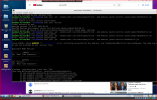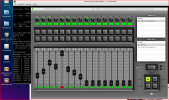To run a B4J console or GUI Application on any 32-bit or 64-bit ARM computer, follow these steps:
Have tested it on Raspberry Pi 4 and Orange Pi Zero 3, 2W running Ubuntu 21.04 and 22.04 respectively:
[edit - Also works with 32-bit Raspberry Pi OS on RPI 3 - see @dave4cbu post below]
[edit - 21-09-2024: This will not work (for obvious reasons) with Libraries such as "ControlsFX" that require Java 8]
[edit 10-01-2025: Tested and works with Ubuntu Linux running on x64 Intel processor based computers and VPSs. So it's not just limited to ARM - See Post#6 ]
STEP 1: Install openjfx11+
sudo apt-get update
sudo apt-get install openjfx
STEP 2: Find out where openJfx is installed
dpkg-query -L openjfx
NOTE: ..... should be installed in /usr/share/openjfx
STEP 3: Install OpenJDK11+ JRE (or whatever version the default JRE is) and check version
sudo apt install default-jre
sudo java -version
STEP 4: Run Program
sudo java -jar --module-path /usr/share/openjfx/lib --add-modules javafx.controls yourB4Jprogram.jar
NOTE: You can run B4J jar files compiled with Oracle Java 8 as well as OpenJDK11+
Note [10-01-2025]: If you get the error message "Authorization required, but no authorization protocol specified" run the above command without the "sudo"
Instead of typing the long command line, you can create a shell script with the above command line and pass your jar file as a parameter:
1. Create a file called "jrun" with the following two lines:
#!/bin/bash
sudo java -jar --module-path /usr/share/openjfx/lib --add-modules javafx.controls $1
2. Make the file executable:
chmod +x jrun
3. Run the program with a simplified command line:
./jrun yourB4Jprogram.jar
Enjoy!
----------------------------------------------------------------------------
Have tested it on Raspberry Pi 4 and Orange Pi Zero 3, 2W running Ubuntu 21.04 and 22.04 respectively:
[edit - Also works with 32-bit Raspberry Pi OS on RPI 3 - see @dave4cbu post below]
[edit - 21-09-2024: This will not work (for obvious reasons) with Libraries such as "ControlsFX" that require Java 8]
[edit 10-01-2025: Tested and works with Ubuntu Linux running on x64 Intel processor based computers and VPSs. So it's not just limited to ARM - See Post#6 ]
STEP 1: Install openjfx11+
sudo apt-get update
sudo apt-get install openjfx
STEP 2: Find out where openJfx is installed
dpkg-query -L openjfx
NOTE: ..... should be installed in /usr/share/openjfx
STEP 3: Install OpenJDK11+ JRE (or whatever version the default JRE is) and check version
sudo apt install default-jre
sudo java -version
STEP 4: Run Program
sudo java -jar --module-path /usr/share/openjfx/lib --add-modules javafx.controls yourB4Jprogram.jar
NOTE: You can run B4J jar files compiled with Oracle Java 8 as well as OpenJDK11+
Note [10-01-2025]: If you get the error message "Authorization required, but no authorization protocol specified" run the above command without the "sudo"
Instead of typing the long command line, you can create a shell script with the above command line and pass your jar file as a parameter:
1. Create a file called "jrun" with the following two lines:
#!/bin/bash
sudo java -jar --module-path /usr/share/openjfx/lib --add-modules javafx.controls $1
2. Make the file executable:
chmod +x jrun
3. Run the program with a simplified command line:
./jrun yourB4Jprogram.jar
Enjoy!
----------------------------------------------------------------------------
Last edited:


